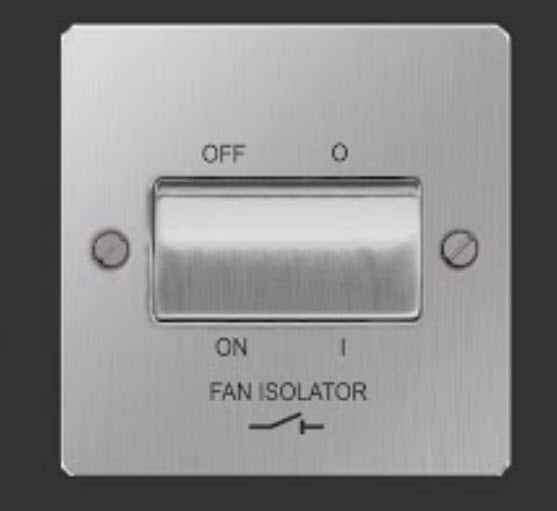If you are having a bathroom fan installed, or doing so yourself, it’s important to decide ahead of time whether or not you need to put in an isolator switch for a bathroom fan. This is a question that has a couple different ways to look at it based on priorities, but generally:
The short answer is that a bathroom fine works great attached to the light and only needs an isolator switch if you want to be able to turn the fan on/off without the light, or vice-versa.
The main idea behind having a fan isolator is wanting the ability to switch a fan off without messing with a light and making maintenance safer by making sure the fan can’t come on accidentally. This allows for some maintenance without having to hit the fuse box.
So what’s the right course of action? Do you need a bathroom fan isolator or not? Let’s dive in.

Why You Should Install an Isolator Switch for a Bathroom Fan
There are several good reasons for installing an isolator switch with a bathroom fan. This is even aside from the fact that if the setup is already there for it based on an old model or design, there’s no good reason to specifically remove that safety feature.
So what are some of the best reasons for installing bathroom fan isolator switches?
Some locations have safety regulations that demand an isolator switch in the bathroom
This is going to vary based on country, state/province, or even county and city levels. Some places have a direct rule regarding this, but in other situations the exact regulation is based off a general blanket regulation like “Any repair which could conceivably cause injury upon a repairman must have a separate safety or kill switch for the protection and safety of the individual doing repairs.”
The idea being that since an electric surge into the fan could easily cause injury, an additional isolator switch is needed. So even if the term “isolator switch” isn’t used exactly, it’s easy to see how under that regulation this could be seen as a reasonable safety step for an electrician.
Gives more versatility and options when doing repairs
While having the two come on at once when you’re taking a shower or just using the bathroom through ordinary functions, being able to have the light on to see clearly while doing home repairs to the fan without worrying about the fan coming on is a major plus.
That’s not just safety, but it’s also a versatility that you don’t get if they are combined. Having that isolator is also not just good for safety and repair but it also gives you some extra convenience for doing those consistent cleanings that are good for the fan, the ventilation, and the general overall welfare of your bathroom setup.
More precise control over bathroom repairs
While you only really need an isolator for the fan if you want to be able to isolate the fan, sometimes just having more precise control is a good thing even if you’re not sure if you need a specific isolator just for the bathroom fan itself.
The ability to more precisely control the circuits and repairs, especially wiring, is a good option to have on the table, regardless of what the immediate needs are or might be.
You want to be able to run the fan without the light
If you’re looking to save on an electric bill, the post shower can be annoying. You understand the importance of making sure to clear the moisture so you don’t have a mold or mildew problem in the long run. But if the two are connected, the light has to stay on.
When the wiring can be done separately, that allows separate switches which allows the on/off separation to take place.
Safety when cleaning the fan
You want the light on while cleaning the fan, especially if this bathroom doesn’t have a window or the only time you have is late at night when you can do the cleaning, you don’t want the fan whirring as you vacuum around the grate, the fan, the rest of it.
Overall there are many, many great reasons to install an isolator switch for a bathroom fan, and there are far fewer good reasons for not putting one in.
Why You Shouldn’t Install an Isolator Switch for a Bathroom Fan
There aren’t actually very many reasons for not wanting an isolater switch for a bathroom fan. Hands down, in most situations going with the switch is the safety move and it makes sense but there are two potential situations where maybe there’s not a need.
An old wiring situation could complicate installation
This is a relatively rare thing, but not impossible. Especially if your house was a family farm house for 100+ years – when it was originally built there weren’t building standards and chances are a lot of independent DIY went into construction, wiring, plumping, repairs, and other things throughout the years in ways that don’t make what should be a simple installation much more difficult.
While a very niche reason, it could conceivably be a reason that installing the isolator switch might make a little less sense.
Budget
This isn’t always the case for sure, but sometimes installing a setup with an isolator switch will be more expensive because of unforeseen challenges. And if you’re at a place in the budget where you are counting every penny, that might be a dealbreaker.
Those are pretty much it. Otherwise if the question comes up whether you’re DIY or having the question asked by an electrician or handyman, you want the isolator switch put in.
Q&A Answer on Bathroom Fan Isolator Switch Installation
In Conclusion
Having handyman skills can make life a lot simpler, and while adding an isolator switch isn’t that complicated if you already have the skills for taking care of a bathroom fan installation, it’s still a decision you want to make up front. On the other hand, even if you are calling in a professional to do the installation, they will want to know what type of model of bathroom fan you want.
Generally speaking if the bathroom is already wired up with the light separate from the fan, that will make it easy to keep it that way. On the other hand, if that’s not the setup, then the additional work needed to connect a switch might be a bit much depending on how old the bathroom, home, design, and wiring all are.
Other bathroom articles you may enjoy
